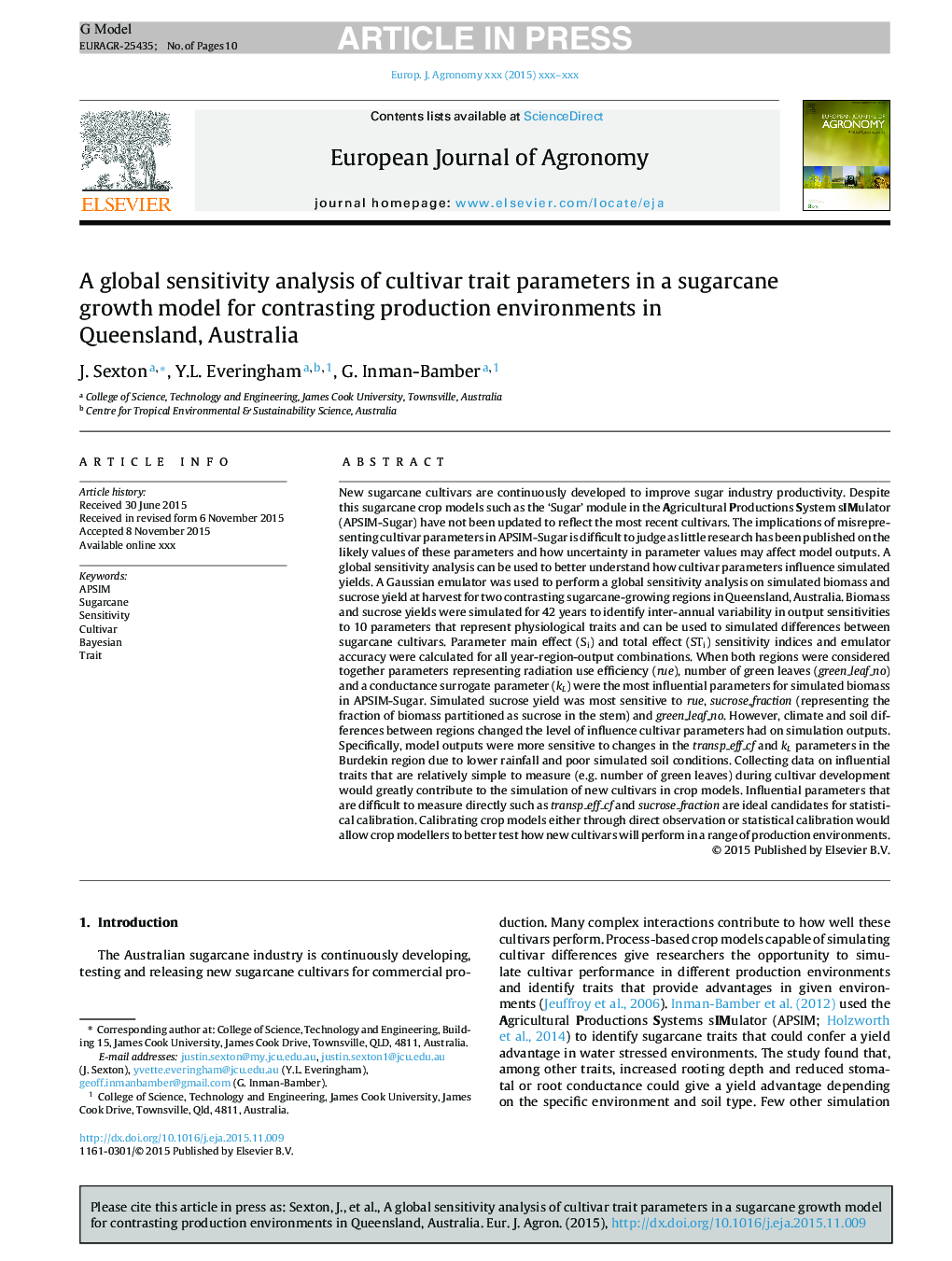| کد مقاله | کد نشریه | سال انتشار | مقاله انگلیسی | نسخه تمام متن |
|---|---|---|---|---|
| 5761262 | 1624436 | 2017 | 10 صفحه PDF | دانلود رایگان |
عنوان انگلیسی مقاله ISI
A global sensitivity analysis of cultivar trait parameters in a sugarcane growth model for contrasting production environments in Queensland, Australia
ترجمه فارسی عنوان
تجزیه و تحلیل حساسیت جهانی پارامترهای صفت رقم در یک مدل رشد نیشکر برای کنتراست محیط تولید در کوئینزلند استرالیا
دانلود مقاله + سفارش ترجمه
دانلود مقاله ISI انگلیسی
رایگان برای ایرانیان
کلمات کلیدی
موضوعات مرتبط
علوم زیستی و بیوفناوری
علوم کشاورزی و بیولوژیک
علوم زراعت و اصلاح نباتات
چکیده انگلیسی
New sugarcane cultivars are continuously developed to improve sugar industry productivity. Despite this sugarcane crop models such as the 'Sugar' module in the Agricultural Productions System sIMulator (APSIM-Sugar) have not been updated to reflect the most recent cultivars. The implications of misrepresenting cultivar parameters in APSIM-Sugar is difficult to judge as little research has been published on the likely values of these parameters and how uncertainty in parameter values may affect model outputs. A global sensitivity analysis can be used to better understand how cultivar parameters influence simulated yields. A Gaussian emulator was used to perform a global sensitivity analysis on simulated biomass and sucrose yield at harvest for two contrasting sugarcane-growing regions in Queensland, Australia. Biomass and sucrose yields were simulated for 42 years to identify inter-annual variability in output sensitivities to 10 parameters that represent physiological traits and can be used to simulated differences between sugarcane cultivars. Parameter main effect (Si) and total effect (STi) sensitivity indices and emulator accuracy were calculated for all year-region-output combinations. When both regions were considered together parameters representing radiation use efficiency (rue), number of green leaves (green_leaf_no) and a conductance surrogate parameter (kL) were the most influential parameters for simulated biomass in APSIM-Sugar. Simulated sucrose yield was most sensitive to rue, sucrose_fraction (representing the fraction of biomass partitioned as sucrose in the stem) and green_leaf_no. However, climate and soil differences between regions changed the level of influence cultivar parameters had on simulation outputs. Specifically, model outputs were more sensitive to changes in the transp_eff_cf and kL parameters in the Burdekin region due to lower rainfall and poor simulated soil conditions. Collecting data on influential traits that are relatively simple to measure (e.g. number of green leaves) during cultivar development would greatly contribute to the simulation of new cultivars in crop models. Influential parameters that are difficult to measure directly such as transp_eff_cf and sucrose_fraction are ideal candidates for statistical calibration. Calibrating crop models either through direct observation or statistical calibration would allow crop modellers to better test how new cultivars will perform in a range of production environments.
ناشر
Database: Elsevier - ScienceDirect (ساینس دایرکت)
Journal: European Journal of Agronomy - Volume 88, August 2017, Pages 96-105
Journal: European Journal of Agronomy - Volume 88, August 2017, Pages 96-105
نویسندگان
J. Sexton, Y.L. Everingham, G. Inman-Bamber,
